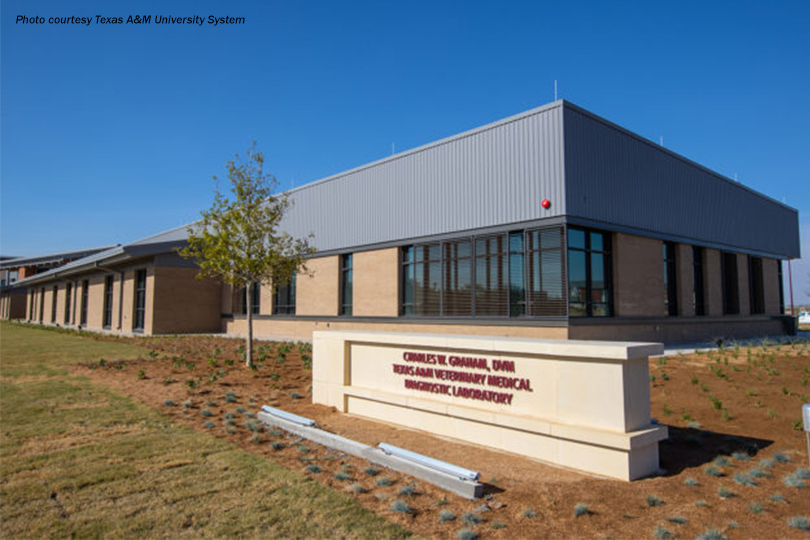By Jennifer Whitlock
Field Editor
The Charles W. “Doc” Graham ’53 DVM, The Texas A&M University System Center officially opened this month to offer veterinary medicine students in the Texas Panhandle state-of-the-art educational facilities.
At the grand opening of the Veterinary Education, Research and Outreach (VERO) and Charles W. Graham DVM Texas A&M Veterinary Medical Diagnostic Laboratory (TVMDL) buildings, leaders said the center will greatly the Texas A&M University System’s contributions to veterinary medicine, particularly in the field of large animal medicine.
“With this partnership at West Texas A&M, the College of Veterinary Medicine and Biomedical Sciences continues to meet both the needs of the state and our students in the most innovative, high-quality, effective and cost-efficient manner possible,” Texas A&M Chancellor John Sharp said at the event. “We have created a two-way superhighway of veterinary education and research activity from Canyon to College Station, and it runs right through the VERO and TVMDL facilities within the Dr. Charles Graham center on the West Texas A&M campus.”
TVDML is one of the Texas A&M University System’s eight state agencies. It is comprised of four labs across Texas that offer bacteriology, pathology, serology and virology diagnostic services.
A TVMDL facility serving the Panhandle area was formerly located in Amarillo, but moving the lab to Canyon allowed for integration into the veterinary medicine center, as well as provided drastic upgrades. The 22,000 square-foot building features the most up-to-date technology and offers spaces for receiving, sample processing and necropsy services.
The previous lab opened in 1975 to service Panhandle feedlots as an extension of the agency’s College Station facility. Texas A&M data shows the Amarillo location performed an estimated 160,000 cattle diagnostic tests each year.
The Canyon laboratory is one of TVMDL’s full-service laboratories, meaning testing is offered for most animal species. However, due to the lab’s location, the bulk of testing will continue to be for the cattle industry.
The importance of having TVMDL facilities across the state has become more apparent in the wake of the COVID-19 pandemic, according to Dr. Patrick J. Stover, vice chancellor of Texas A&M AgriLife.
“Factor in the countless daily threats that have the potential to wreak havoc on livestock and companion animals, and it’s more important than ever to be vigilant when it comes to animal health,” he said. “This is why we constructed a new laboratory for TVMDL—to continue to provide disease surveillance and protection for our livestock and human populations in Texas and around the globe.”
The VERO building is the keystone to Texas A&M University offering advanced degrees in veterinary medicine outside College Station. Students at West Texas A&M University (WTAMU) can enroll in the 2+2 program in Canyon to pursue their Doctor of Veterinary Medicine (DVM).
“Our program is designed to provide the first two years of the DVM program in Canyon and affords students from the Panhandle the opportunity to gain access to veterinary education close to home. The VERO facilities are designed for teaching didactic and laboratory courses of the preclinical veterinary program,” Dr. Karen Cornell, associate dean for Professional Programs in the College of Veterinary Medicine & Biomedical Sciences, said. “Students will come to College Station to practice clinical medicine with state-of-the-art medical facilities and faculty in the referral and primary care settings of our hospital. Additionally, all DVM students will have the opportunity to participate in clinical rotations during the fourth year at VERO and TVMDL in Canyon and the surrounding veterinary and production communities of the Panhandle.”
The 2+2 program will enroll its first class of 18 students this fall, with the first graduates expected in 2025. Pre-veterinary medicine students will also learn at the VERO facility.
“We focus on educational excellence at Texas A&M University. Our goal is to provide students—both in College Station and at VERO—the opportunity to integrate the knowledge and science with hands-on experiences to create the best possible veterinary graduate,” Dr. Kristin Chaney, director for Curriculum Development & Outcomes Assessment, said. “By expanding to the West Texas/Panhandle region, we provide a greater opportunity for an even larger number of students to take advantage of the world-class DVM education offered by Texas A&M University.”

